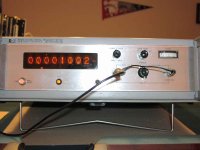Micom 2000
Veteran Member
The Tools section hasn't had a post for over a month. The thread in the forsale section had an interesting thread on a Heathkit VTVM which expanded to oscilloscopes and other things.
Common was the view that one of the Monitors would move it to "off-topic", but eager to talk about it. I hesitated about mentioning my old Dumont Scope from the mid-fifties as well as many other ancient electronic "Tools" such as frequency generators or an old "Decade" box. A google found that even the Computer History Museum has a Dumont scope in it's collection. Surely vintage or otherwise, "Tools" isn't limited to soldering irons or Tork screwdrivers. It's about electronics. Scopes, VTVMs, and continuity testers are all part of many collectors tools. Even Tubes (Valves) enter into it.
Tools could be a very interesting section if it opened up. Had the Heathkit thread been transferred here it would have likely be still continuing. Perhaps with this thread it can be.
What tools do you have for testing and repairing computers ? Some of the stuff Tezzi does with his computer tools amazes me as well as what many other posters efforts do.
Lawrence
Common was the view that one of the Monitors would move it to "off-topic", but eager to talk about it. I hesitated about mentioning my old Dumont Scope from the mid-fifties as well as many other ancient electronic "Tools" such as frequency generators or an old "Decade" box. A google found that even the Computer History Museum has a Dumont scope in it's collection. Surely vintage or otherwise, "Tools" isn't limited to soldering irons or Tork screwdrivers. It's about electronics. Scopes, VTVMs, and continuity testers are all part of many collectors tools. Even Tubes (Valves) enter into it.
Tools could be a very interesting section if it opened up. Had the Heathkit thread been transferred here it would have likely be still continuing. Perhaps with this thread it can be.
What tools do you have for testing and repairing computers ? Some of the stuff Tezzi does with his computer tools amazes me as well as what many other posters efforts do.
Lawrence


